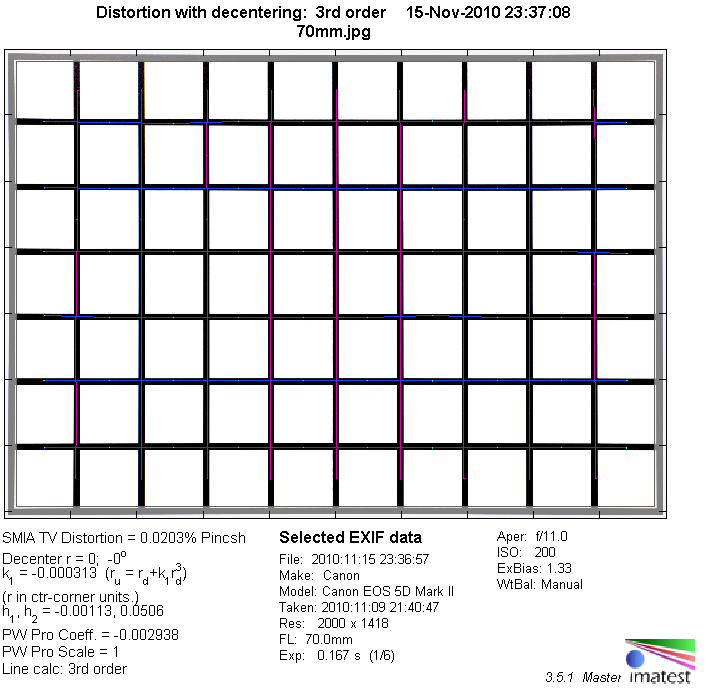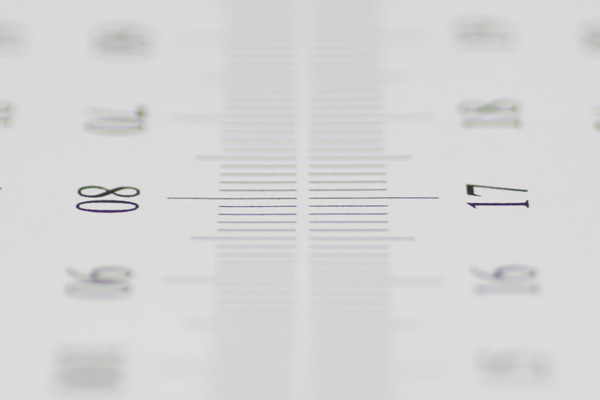|
Sigma AF 70mm f/2.8 EX DG macro - Full Format Lab Test / Review - Analysis |
|
Lens Reviews -
Canon EOS (Full Format)
|
|
Page 2 of 2

Distortion
Typical for macro lenses the Sigma shows an extremely low level of distortion which is
absolutely negligible in field conditions.

The chart above has a real-world size of about 120x80cm.
Vignetting
The Sigma lens produces some vignetting at max. aperture (1EV) but this is still
comparatively moderate within the full format test scope. The problem is basically
gone from f/4 onwards.

MTF (resolution)
Macro lenses tend to be stellar performer thanks to a usually very conservative
max. aperture and the Sigma follows this tradition. The resolution characteristic
is generally excellent straight from f/2.8 all the way down to f/8 with a slight
peak in the f/4-5.6 vicinity. Due to the usual diffraction effects the resolution
is reduced to good+ levels at f/16 and good- quality at f/22.
Please note that the resolution tests are performed at conventional focus distances.
True macro tests are not possible at this stage.
The tested sample showed a slight centering problem on the left side of the image field.
Please note that the MTF results are not directly comparable across the different systems!
Below is a simplified summary of the formal findings. The chart shows line widths per picture height (LW/PH) which can be taken as a measure for sharpness.
If you want to know more about the MTF50 figures you may check out the corresponding Imatest Explanations
Chromatic Aberrations (CAs)
Lateral CAs (color shadows at the image borders) are very well controlled within the full
format testing scope. There're only very minor traces of purple fringing at f/2.8.
Please note that lateral CAs can be corrected without any significant impacts via tools.

Bokeh
The bokeh (the quality of the out-of-focus blur) is a primary aspect for a macro lens and the Sigma lens does shine here.
Out-of-focus highlights are very uniform and perfectly circular at f/2.8. The shape deteriorates a little at f/4 but edges
are only really noticeable from f/5.6 onwards. The critical focus transition zones are very smooth even at max. aperture.

Bokeh Fringing / Longitudinal Chromatic Aberrations (LoCA)
Bokeh fringing is a common problem among large aperture lenses. However, the Sigma shows only traces of LoCAs at f/2.8 and the problem isn't really relevant anymore from f/4 onwards.
|
Move the mouse cursor over the f-stop marks below to observe the respective LoCAs
|
| f/2.8 |
f/4 |
f/5.6 |
|

|
Verdict
The Sigma AF 70mm f/2.8 EX DG macro is capable to deliver exceptionally sharp
results throughout most of the aperture range. The bokeh (out-of-focus blur) is very
smooth and buttery and bokeh fringing isn't a really significant issue. Typical for macro
lenses it also produces a negligible degree of distortions. Lateral CAs
(color shadows at the image borders) are very low in absolute terms albeit a little higher
than average for a macro lens. The Sigma lens has one distinctive weak sport - the AF. Its
accuracy is fine but it is both very slow and noisy. The build quality is on a very high level
thanks to a metal construction and tight tolerances.
|